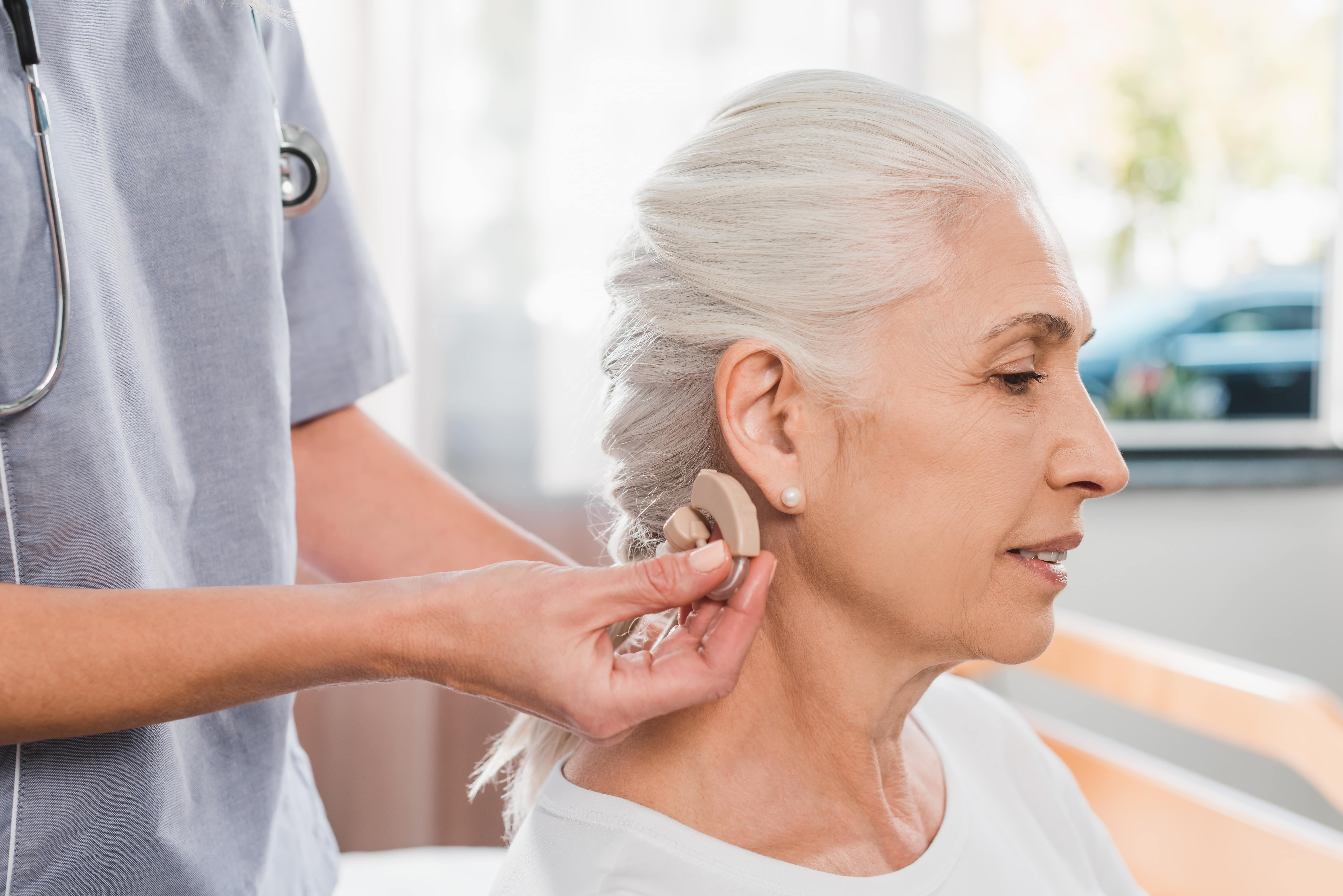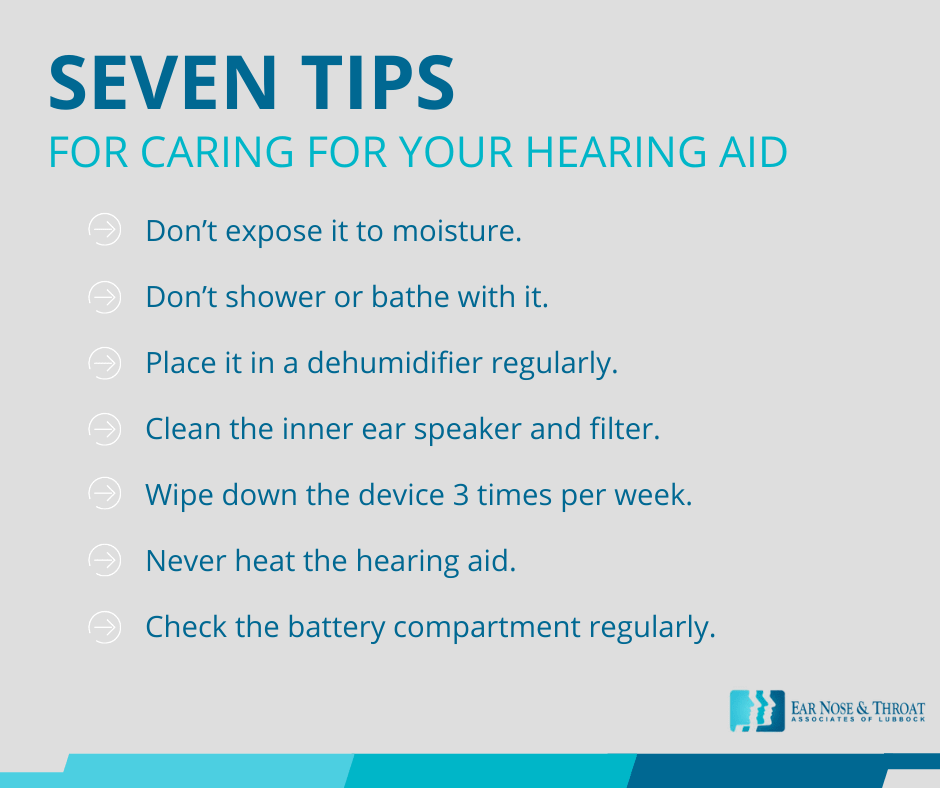The Audiologist’s Guide to Hearing Aid Care & Cleaning

Hearing aids are like your teeth — you need to brush them every day to keep them clean.
A device like a hearing aid requires special care. And while that care isn’t necessarily complicated, it does need to be regular. Here’s how to clean your hearing aids… and why it’ll make a difference.
Why Do I Need to Clean My Hearing Aid?
Out in West Texas, we’re no strangers to dust. Our time outside often puts us in high winds that blow the dust and dirt in all directions. If you’re wearing a hearing aid, the dust likely gets into the microphone and other surfaces of your hearing device as well.
In different climates, people might be exposed to pollen or other air debris. But even those who stay inside are regularly exposed to debris that can interfere with the function of hearing aids. Hairspray, other cosmetic products, and skin cells can also get into the microphones of the hearing aid.
No matter what kind of climate or conditions you face daily, cleaning your device with a small brush can help it function at its best.
How To Clean Hearing Aids
You have to keep the microphone and speaker clean to best hear from the hearing aid. Each night, brush over the surface of the hearing aid (with the small brush that comes with the hearing aid or a baby toothbrush) to make sure the microphone stays clean of debris.
This easy daily process is the best way to care for your hearing aid. Dust, debris, and hair products can quickly plug up the microphone, causing the hearing aid to sound weak… or not work at all. If uncleaned, this buildup can lead to repairs that could be avoided with daily brushing.

7 Tips For Caring For Your Hearing Aid
While daily brushing is a must, you should also practice these habits to keep your hearing aid functioning optimally:
1. Don’t expose it to moisture.
Avoid storing it in the bathroom.
2. Don’t shower or bathe with it.
The hearing aid should not get wet. But, we know accidents happen. If you accidentally expose it to water, toss the battery and let it air dry, or put the hearing aid in a dry-aid kit or dehumidifier as soon as you can.
3. Place it in a dehumidifier regularly.
We give our patients a dehumidifier at the end of their trial period. This electronic device blows warm air to dry out hearing aids. Normal usage can cause a little moisture to build up, but keeping it dry helps a hearing aid work like it’s supposed to. It also helps prevent rust from forming in the device.
4. Clean the inner ear speaker and filter.
The microphone behind the ear isn’t the only piece that needs cleaning. The speaker inside the ear canal at the end of the wire needs cleaning too. This receiver port must stay clean of debris (ear wax, dead skin, drainage). If debris builds up in the port, sound can’t come out and you can’t hear anything.
As a part of your routine, look at the speaker every night and see if there’s any debris. If you see anything, brush or pick it out (depending on your tool and hearing aid set up).
If you have a filter, replace it when it seems full.
5. Wipe down the device 3 times per week.
At our office, we offer pre-moistened wipes safe for hearing aid use. Patients should wipe down the hearing aid a few times per week to help remove sticky wax residue from the hearing aid.
6. Never heat the hearing aid.
Do not put the hearing aid in the microwave or oven to dry it out. Also, avoid leaving it on the dashboard of a parked car. It can melt – especially under the Texas sun in the summer.
7. Check the battery compartment regularly.
If you have disposable batteries in your hearing aid, occasionally open the battery door and clean out the battery compartment with the brush. If uncleaned, debris and rust can build up inside this compartment, creating poor battery contact.
What To Do When Something Breaks
Most of the parts that break on a hearing aid need to be fixed in the office. However, if a supply piece like a dome or a tip tears during cleaning, a patient may be able to replace these at home. We often give our patients extra pieces so they can easily fix these on their own if they so choose. However, we also can replace domes or tips in the office. If a battery door snaps off, we can replace that in the office as well.
For more significant damage to the hearing aid, we send the device to the manufacturer to fix the issue for you. We recommend using the manufacturer for all significant repairs as they provide the best service for their specific devices.
How To Store Your Hearing Aid
When you are not wearing your hearing aids, put them in a safe place where you can remember them. Make sure this place does not expose them to moisture.
Also, make sure they’re not in a place where they can be accidentally brushed into the floor or handled by a pet or kids. Hearing aid batteries are highly toxic. Lithium-ion batteries are even more toxic than older-style disposable batteries. We want to make sure these don’t accidentally get ingested by pets or children.
Related: What Does an Audiologist Do? Everything You Need to Know
Learning how to clean and care for hearing aids isn’t complicated once it becomes part of your routine. Finding a safe place to regularly store them, remembering to brush them each night, and regularly checking them for cleanliness can go a long way in keeping your hearing aid functioning at its best.
Dr. Thackrey has been providing Audiology services to West Texas residents since 2006. She is licensed in the State of Texas and is a member of the American Speech-Language-Hearing Association (ASHA). She specializes in hearing evaluations of all ages, but is especially skilled in the selection, fitting, programming and servicing of hearing aids. Learn more about Dr. Thackrey
Categories:







